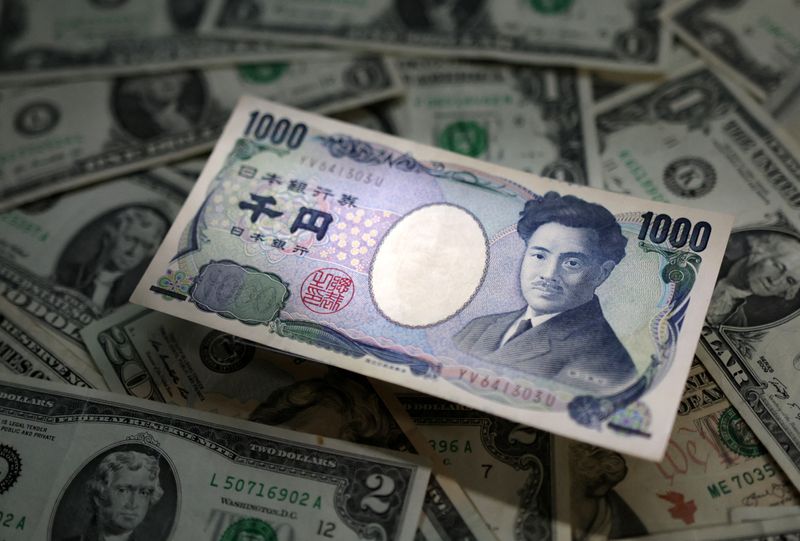Forex
Dollar strengthens versus yen as BOJ strikes cautious stance on rate hikes

By Chibuike Oguh and Linda Pasquini
NEW YORK/LONDON (Reuters) -The dollar strengthened against the yen on Friday, hitting its highest level in two weeks, after the Bank of Japan left interest rates unchanged and indicated that it was not in a hurry to hike them again.
The BOJ could afford to spend time eyeing the fallout from global economic uncertainties, Governor Kazuo Ueda said in a press conference following the central bank’s move, adding that its monetary policy decision will be based on “economic, price and financial developments.” The BOJ kept rates steady at 0.25%, a move that was widely expected.
The dollar rose as high as 144.50 yen, reaching its highest level since early September. It was last up 0.92% at 143.92. The euro also strengthened against the yen, gaining 0.93% to 160.59.
“We’re seeing a little bit of consolidation in markets that got the dollar-yen move, which has been quite significant in the past few days since the Fed,” said Shaun Osborne, chief FX strategist at Scotiabank in Toronto, referring to the Federal Reserve’s decision on Wednesday to cut interest rates by half a percentage point.
“The statement sounded perhaps a little bit more cautious than markets would have liked given the assumption that we will see another rate cut from the Bank of Japan before Christmas. I still think that’s likely.”
The dollar has traded in a choppy fashion since the Fed kicked off its monetary policy easing cycle.
Against the dollar, however, the euro weakened 0.01% to $1.115925. The , which measures the greenback against major currencies, gained slightly to 100.75 and just above a one-year low.
“There’s a sense in the market that the Bank of Japan doesn’t need to hike rates and also we’re turning more to the political situation in Japan,” said Adam Button, chief currency analyst at ForexLive in Toronto.
Markets imply nearly a 49% chance the Fed will deliver another 50-basis-point rate cut in November and have priced in 74.8 bps of cuts by the end of this year. The Fed’s policy rate is expected by the end of 2025 to be at 2.85%, which is now thought to be the Fed’s estimate of the neutral rate.
That dovish outlook has bolstered hopes for continued U.S. economic growth and sparked a major rally in risk assets. Currencies leveraged to global growth and commodity prices also benefited, with the Australian dollar reaching as high as $0.68285. It was last down 0.13% to $0.68060.
“It runs counter-intuitive to what we’ve seen in the market, with a big cut from the Fed and the Bank of Japan holding rates. I think that the message really from dollar-yen is that the market is feeling better about global growth,” Button said.
China unexpectedly left benchmark lending rates unchanged at the monthly fixing on Friday. Beijing has been hinting at other stimulus measures, enabled in part by the Fed’s aggressive easing that shoved the dollar to a 16-month low against the yuan.
Major Chinese state-owned banks were seen buying dollars in the onshore spot foreign exchange market on Friday to prevent the yuan from appreciating too fast, two people with knowledge of the matter said. The dollar weakened 0.23% to 7.043 versus the offshore .
The Bank of England kept rates unchanged on Thursday, with its governor saying the central bank had to be “careful not to cut too fast or by too much.”
The pound was up 0.24% at $1.33180, supported by the release on Friday of strong British retail sales data.
Currency bid prices at 20
September 06:46 p.m. GMT
Description RIC Last U.S. Close Previous Session Pct Change YTD Pct High Bid Low Bid
Dollar index 100.74 100.67 0.07% -0.62% 101.01 100.41
Euro/Dollar 1.1162 1.1162 -0.01% 1.11% $1.1181 $1.1136
Dollar/Yen 143.84 142.62 0.9% 2.03% 144.485 141.84
Euro/Yen 1.1162 159.19 0.85% 3.16% 161.15 158.43
Dollar/Swiss 0.8506 0.8478 0.35% 1.09% 0.8516 0.8453
Sterling/Dollar 1.3314 1.3286 0.22% 4.63% $1.3341 $1.3269
Dollar/Canadian 1.356 1.3557 0.04% 2.31% 1.359 1.3543
Aussie/Dollar 0.6806 0.6815 -0.13% -0.18% $0.6829 $0.6784
Euro/Swiss 0.9494 0.9462 0.34% 2.22% 0.9503 0.9447
Euro/Sterling 0.838 0.8401 -0.25% -3.32% 0.8407 0.8382
NZ Dollar/Dollar 0.6237 0.6242 -0.06% -1.29% $0.6258 0.621
Dollar/Norway 10.4989 10.4814 0.17% 3.59% 10.561 10.4482
Euro/Norway 11.7197 11.699 0.18% 4.42% 11.7702 11.681

Dollar/Sweden 10.1778 10.1512 0.26% 1.1% 10.2309 10.138
Euro/Sweden 11.3604 11.338 0.2% 2.11% 11.3988 11.3326

 Forex3 years ago
Forex3 years agoForex Today: the dollar is gaining strength amid gloomy sentiment at the start of the Fed’s week

 Forex3 years ago
Forex3 years agoUnbiased review of Pocket Option broker

 Forex3 years ago
Forex3 years agoDollar to pound sterling exchange rate today: Pound plummeted to its lowest since 1985

 Forex3 years ago
Forex3 years agoHow is the Australian dollar doing today?

 Cryptocurrency3 years ago
Cryptocurrency3 years agoWhat happened in the crypto market – current events today

 World3 years ago
World3 years agoWhy are modern video games an art form?

 Commodities3 years ago
Commodities3 years agoCopper continues to fall in price on expectations of lower demand in China

 Economy3 years ago
Economy3 years agoCrude oil tankers double in price due to EU anti-Russian sanctions





















